Improved Performance of NbOx Resistive Switching Memory by In-Situ N Doping
Abstract
:1. Introduction
2. Experimental Section
3. Results and Discussion
4. Conclusions
Supplementary Materials
Author Contributions
Funding
Institutional Review Board Statement
Informed Consent Statement
Data Availability Statement
Conflicts of Interest
References
- Zidan, M.A.; Strachan, J.P.; Lu, W.D. The future of electronics based on memristive systems. Nat. Electron. 2018, 1, 22–29. [Google Scholar] [CrossRef]
- Banerjee, W.; Zhang, X.; Luo, Q.; Lv, H.; Liu, Q.; Long, S.; Liu, M. Design of CMOS Compatible, High-Speed, Highly-Stable Complementary Switching with Multilevel Operation in 3D Vertically Stacked Novel HfO2/Al2O3/TiOx (HAT) RRAM. Adv. Electron. Mater. 2018, 4, 1700561. [Google Scholar] [CrossRef]
- Gao, S.; Yi, X.; Shang, J.; Liu, G.; Li, R.W. Organic and hybrid resistive switching materials and devices. Chem. Soc. Rev. 2019, 48, 1531–1565. [Google Scholar] [CrossRef] [PubMed]
- Wang, Z.; Wu, H.; Burr, G.W.; Hwang, C.S.; Wang, K.L.; Xia, Q.; Yang, J.J. Resistive switching materials for information processing. Nat. Rev. Mater. 2020, 5, 173–195. [Google Scholar] [CrossRef]
- Zhang, Z.; Wang, Z.; Shi, T.; Bi, C.; Rao, F.; Cai, Y.; Liu, Q.; Wu, H.; Zhou, P. Memory materials and devices: From concept to application. InfoMat 2020, 2, 261–290. [Google Scholar] [CrossRef] [Green Version]
- Sebastian, A.; le Gallo, M.; Khaddam-Aljameh, R.; Eleftheriou, E. Memory devices and applications for in-memory computing. Nat. Nanotechnol. 2020, 15, 529–544. [Google Scholar] [CrossRef]
- Paul, F.; Paul, S. To Be or Not to Be—Review of electrical bistability mechanisms in polymer memory devices. Small 2022, 2106442, 2106442. [Google Scholar] [CrossRef]
- Wang, X.F.; Tian, H.; Liu, Y.; Shen, S.; Yan, Z.; Deng, N.; Yang, Y.; Ren, T.L. Two-mode MoS2 filament transistor with extremely low subthreshold swing and record high on/off ratio. ACS Nano. 2019, 13, 2205–2212. [Google Scholar] [CrossRef]
- Sun, L.; Hwang, G.; Choi, W.; Han, G.; Zhang, Y.; Jiang, J.; Zheng, S.; Watanabe, K.; Taniguchi, T.; Zhao, M.; et al. Ultralow switching voltage slope based on two-dimensional materials for integrated memory and neuromorphic applications. Nano Energy 2020, 69, 104472. [Google Scholar] [CrossRef]
- Hussain, T.; Abbas, H.; Youn, C.; Lee, H.; Boynazarov, T.; Ku, B.; Jeon, Y.R.; Han, H.; Lee, J.H.; Choi, C.; et al. Cellulose nanocrystal based bio-memristor as a green artificial synaptic device for neuromorphic computing applications. Adv. Mater. Technol. 2022, 7, 2100744. [Google Scholar] [CrossRef]
- Bae, J.; Hwang, I.; Jeong, Y.; Kang, S.O.; Hong, S.; Son, J.; Choi, J.; Kim, J.; Park, J.; Seong, M.J.; et al. Coexistence of bi-stable memory and mono-stable threshold resistance switching phenomena in amorphous NbOx films. Appl. Phys. Lett. 2012, 100, 062902. [Google Scholar] [CrossRef] [Green Version]
- Herzig, M.; Weiher, M.; Ascoli, A.; Tetzlaff, R.; Mikolajick, T.; Slesazeck, S. Improvement of NbOx-based threshold switching devices by implementing multilayer stacks. Semicond. Sci. Technol. 2019, 34, 075005. [Google Scholar] [CrossRef]
- Fang, Y.; Wang, Z.; Cheng, C.; Yu, Z.; Zhang, T.; Yang, Y.; Cai, Y.; Huang, R. Investigation of NbOx-based volatile switching device with self-rectifying characteristics. Sci. China Inf. Sci. 2019, 62, 229401. [Google Scholar] [CrossRef] [Green Version]
- Aziz, J.; Kim, H.; Rehman, S.; Khan, M.F.; Kim, D.K. Chemical nature of electrode and the switching response of rf-sputtered NbOx films. Nanomaterials 2020, 10, 2164. [Google Scholar] [CrossRef]
- Aziz, J.; Kim, H.; Rehman, S.; Kadam, K.D.; Patil, H.; Aftab, S.; Khan, M.F.; Kim, D.k. Discrete memristive levels and logic gate applications of Nb2O5 devices. J. Alloys Compd. 2021, 879, 160385. [Google Scholar] [CrossRef]
- Xu, J.; Wang, H.; Zhu, Y.; Liu, Y.; Zou, Z.; Li, G.; Xiong, R. Tunable digital-to-analog switching in Nb2O5-based resistance switching devices by oxygen vacancy engineering. Appl. Surf. Sci. 2022, 579, 152114. [Google Scholar] [CrossRef]
- Park, J.H.; Kim, S.H.; Kim, S.G.; Heo, K.; Yu, H.Y. Nitrogen-induced filament confinement technique for a highly reliable hafnium-based electrochemical metallization threshold switch and its application to flexible logic circuits. ACS Appl. Mater. Interfaces 2019, 11, 9182–9189. [Google Scholar] [CrossRef]
- Sedghi, N.; Li, H.; Brunell, I.F.; Dawson, K.; Potter, R.J.; Guo, Y.; Gibbon, J.T.; Dhanak, V.R.; Zhang, W.D.; Zhang, J.F.; et al. The role of nitrogen doping in ALD Ta2O5 and its influence on multilevel cell switching in RRAM. Appl. Phys. Lett. 2017, 110, 102902. [Google Scholar] [CrossRef] [Green Version]
- Yang, M.; Bae, J.H.; Yang, C.W.; Benayad, A.; Baik, H. Formation of an oxygen vacancy-dinitrogen complex in nitrogen-doped hafnium oxide. J. Anal. At. Spectrom. 2013, 28, 482–487. [Google Scholar] [CrossRef]
- Kim, T.; Kim, S.H.; Park, J.H.; Park, J.; Park, E.; Kim, S.G.; Yu, H.Y. An artificial neuron using a bipolar electrochemical metallization switch and its enhanced spiking properties through filament confinement. Adv. Electron. Mater. 2021, 7, 2000410. [Google Scholar] [CrossRef]
- Wagner, C.; Riggs, W.M.; Ddaavis, L.E.; Moulder, J.F.; Muilenberg, G.E. Handbook of X-ray Photoelectron Spectroscopy; Perkin-Eimer Corporation: Waltham, MA, USA, 1979. [Google Scholar]
- Ge, J.; Chaker, M. Oxygen vacancies control transition of resistive switching mode in single-crystal TiO2 memory device. ACS Appl. Mater. Interfaces 2017, 9, 16327–16334. [Google Scholar] [CrossRef] [PubMed]
- Fang, J.; Wang, F.; Qian, K.; Bao, H.; Jiang, Z.; Huang, W. Bifunctional N-doped mesoporous TiO2 Photocatalysts. J. Phys. Chem. 2008, 112, 18150–18156. [Google Scholar] [CrossRef]
- Asahi, R.; Morikawa, T.; Ohwaki, T.; Aoki, K.; Taga, Y. Visible-light photocatalysis in nitrogen-doped titanium oxides. Science 2001, 293, 269–271. [Google Scholar] [CrossRef] [PubMed]
- Zhou, Y.; Wen, T.; Kong, W.; Yang, B.; Wang, Y. The impact of nitrogen doping and reduced-niobium self-doping on the photocatalytic activity of ultra-thin Nb3O8- nanosheets. Dalt. Trans. 2017, 46, 13854–13861. [Google Scholar] [CrossRef] [PubMed]
- Xu, Z.; Wu, J.; Wu, T.; Bao, Q.; He, X.; Lan, Z.; Lin, J.; Huang, M.; Huang, Y.; Fan, L. Tuning the fermi level of TiO2 electron transport layer through Europium doping for highly efficient perovskite solar cells. Energy Technol. 2017, 5, 1820–1826. [Google Scholar] [CrossRef] [Green Version]
- Wang, Y.; Liu, Q.; Long, S.; Wang, W.; Wang, Q.; Zhang, M.; Zhang, S.; Li, Y.; Zuo, Q.; Yang, J.; et al. Investigation of resistive switching in Cu-doped HfO2 thin film for multilevel non-volatile memory applications. Nanotechnology 2010, 21, 045202. [Google Scholar] [CrossRef]
- Sahoo, S. Conduction and switching behavior of e-beam deposited polycrystalline Nb2O5 based nano-ionic memristor for non-volatile memory applications. J. Alloys Compd. 2021, 866, 158394. [Google Scholar] [CrossRef]
- Zhou, Z.; Yang, M.; Fu, Z.; Wang, H.; Ma, X.; Gao, H. Electrode-induced polarity conversion in Nb2O5/NbOx resistive switching devices. Appl. Phys. Lett. 2020, 117, 243502. [Google Scholar] [CrossRef]
- Ossorio, G.; Vinuesa, G.; García, H.; Sahelices, B.; Dueñas, S.; Castán, H.; Ritala, M.; Leskelaˇ, M.; Kemell, M.; Kukli, K. Analysis of the performance of Nb2O5-doped SiO2-based MIM devices for memory and neural computation applications. Solid. State. Electron. 2021, 186, 2–5. [Google Scholar] [CrossRef]
- Lee, K.; Kim, J.; Mok, I.S.; Na, H.; Ko, D.H.; Sohn, H.; Lee, S.; Sinclair, R. RESET-first unipolar resistance switching behaviour in annealed Nb2O5 films. Thin Solid Films 2014, 558, 423–429. [Google Scholar] [CrossRef]
- Roy, S.; Niu, G.; Wang, Q.; Wang, Y.; Zhang, Y.; Wu, H.; Zhai, S.; Shi, P.; Song, S.; Song, Z.; et al. Toward a reliable synaptic simulation using Al-doped HfO2 RRAM. ACS Appl. Mater. Interfaces 2020, 12, 10648–10656. [Google Scholar] [CrossRef] [PubMed]
- Wang, Y.; Liu, H.; Wang, X.; Zhao, L. Impacts of Cu-doping on the performance of La-based RRAM devices. Nanoscale Res. Lett. 2019, 14, 224. [Google Scholar] [CrossRef] [PubMed]
- Chen, Z.; Zhang, Y.; Yu, Y.; Cao, M.; Che, Y.; Jin, L.; Li, Y.; Li, Q.; Li, T.; Dai, H.; et al. Light assisted multilevel resistive switching memory devices based on all-inorganic perovskite quantum dots. Appl. Phys. Lett. 2019, 114, 181103. [Google Scholar] [CrossRef]
- Kim, S.; Jeong, H.Y.; Choi, S.Y.; Choi, Y.K. Comprehensive modeling of resistive switching in the Al/TiOx/TiO2/Al heterostructure based on space-charge-limited conduction. Appl. Phys. Lett. 2010, 97, 033508. [Google Scholar] [CrossRef] [Green Version]
- Xiong, K.; Robertson, J.; Clark, S.J. Passivation of oxygen vacancy states in HfO2 by nitrogen. J. Appl. Phys. 2006, 99, 044105. [Google Scholar] [CrossRef] [Green Version]
- Umezawa, N.; Shiraishi, K.; Ohno, T.; Watanabe, H.; Chikyow, T.; Torii, K.; Yamabe, K.; Yamada, K.; Kitajima, H.; Arikado, T. First-principles studies of the intrinsic effect of nitrogen atoms on reduction in gate leakage current through Hf-based high-k dielectrics. Appl. Phys. Lett. 2005, 86, 143507. [Google Scholar] [CrossRef]
- Schmitt, R.; Spring, J.; Korobko, R.; Rupp, J.L.M. Design of oxygen vacancy configuration for memristive systems. ACS Nano. 2017, 11, 8881–8891. [Google Scholar] [CrossRef]
- Yuan, F.Y.; Deng, N.; Shih, C.C.; Tseng, Y.T.; Chang, T.C.; Chang, K.C.; Wang, M.H.; Chen, W.C.; Zheng, H.X.; Wu, H.; et al. Conduction mechanism and improved endurance in HfO2-Based RRAM with nitridation treatment. Nanoscale Res. Lett. 2017, 12, 3–8. [Google Scholar] [CrossRef]
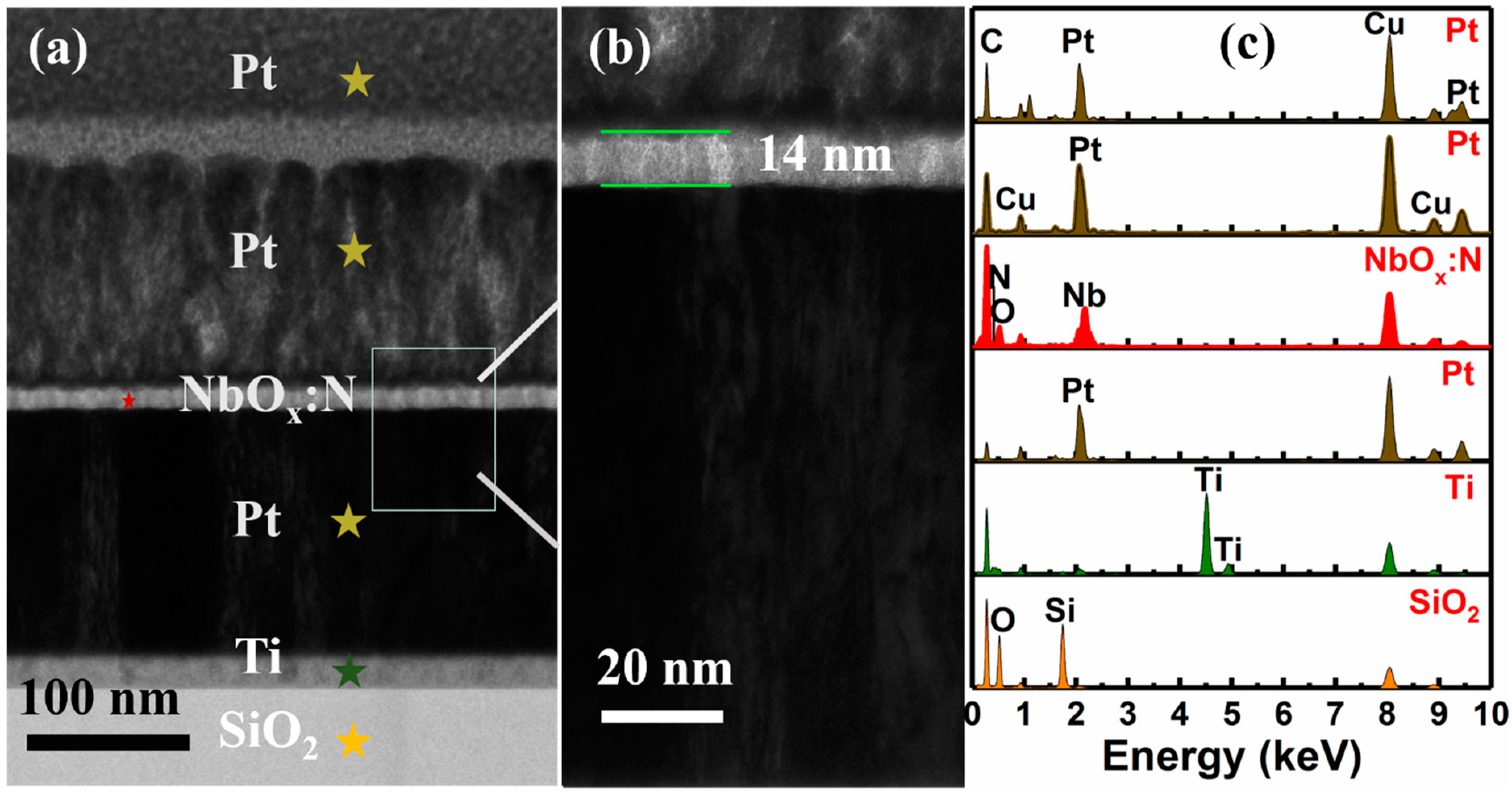

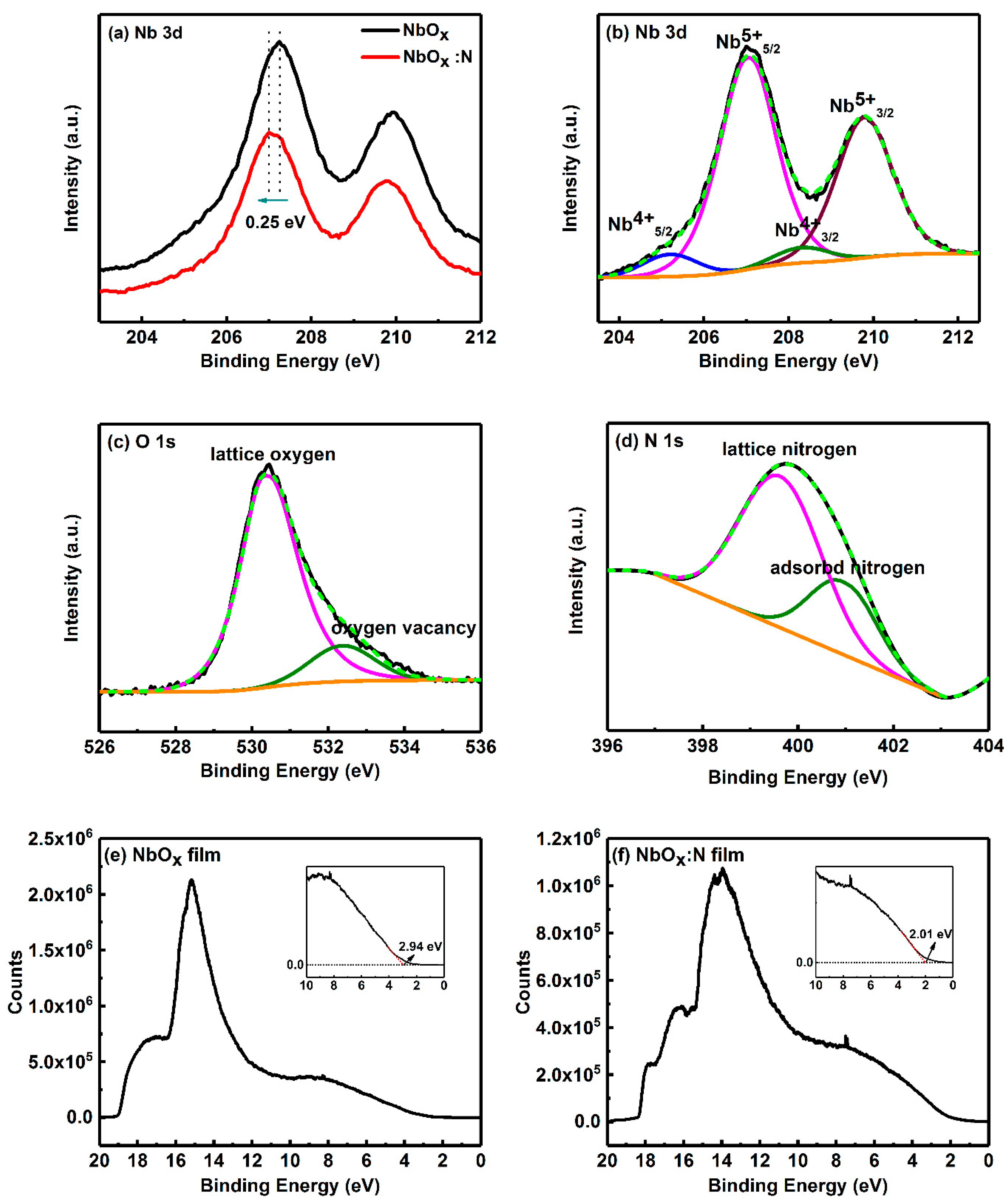
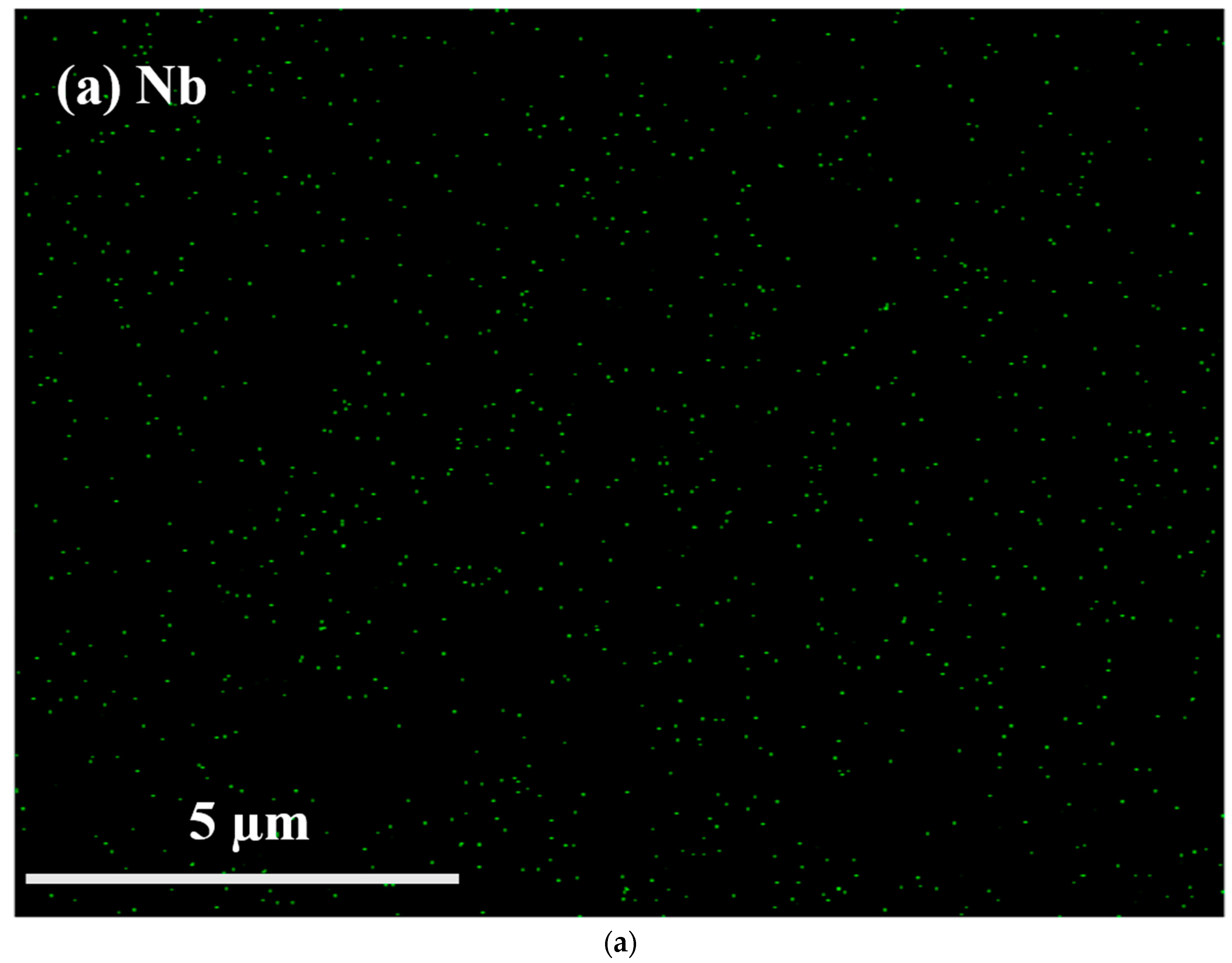
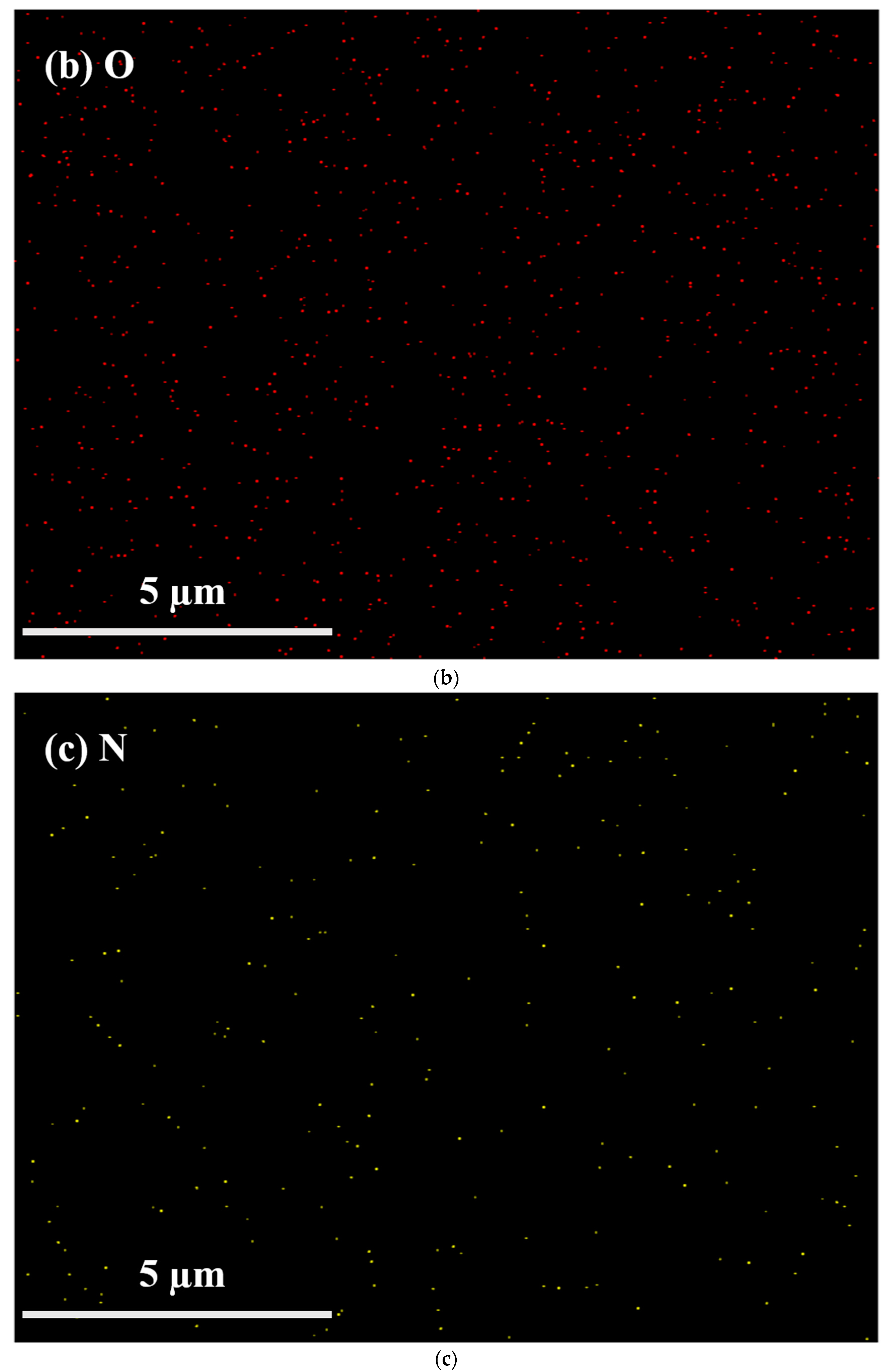
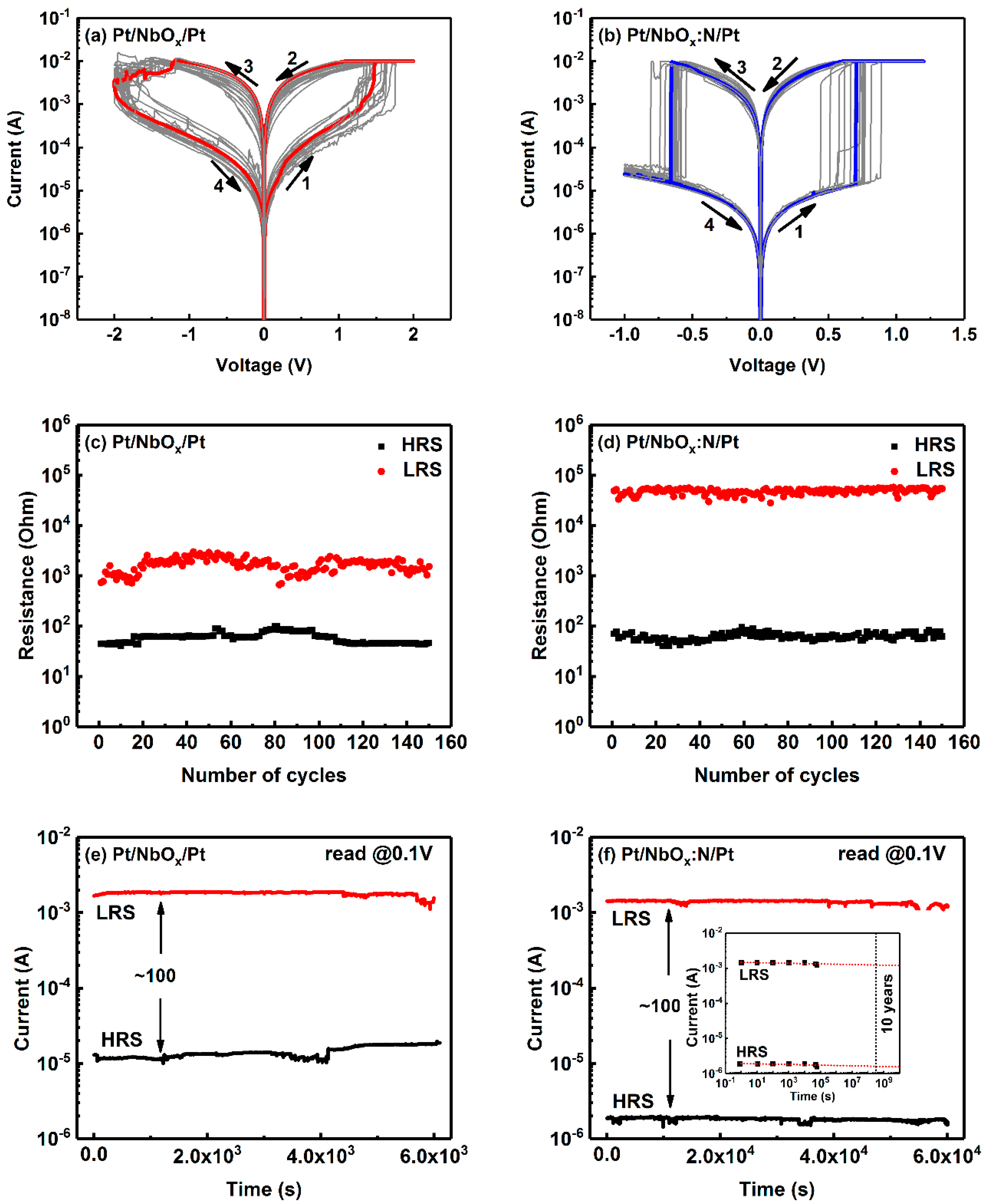

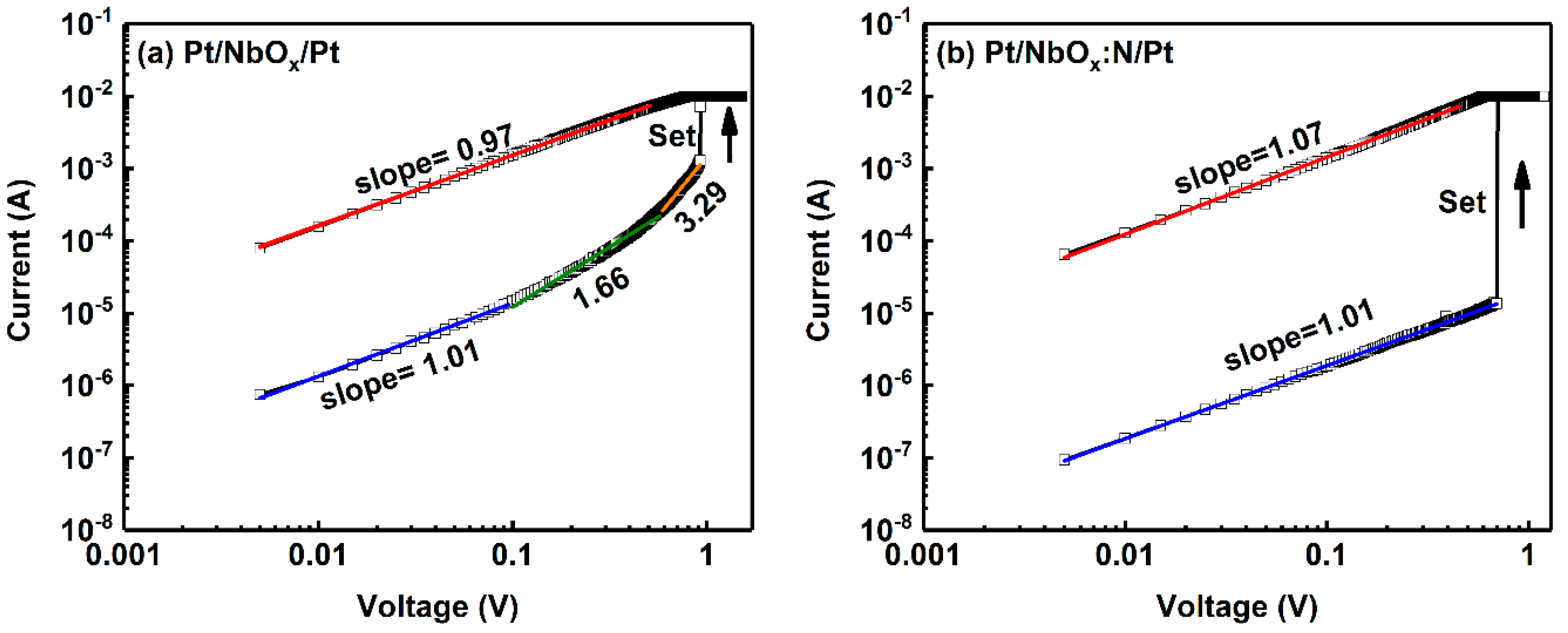
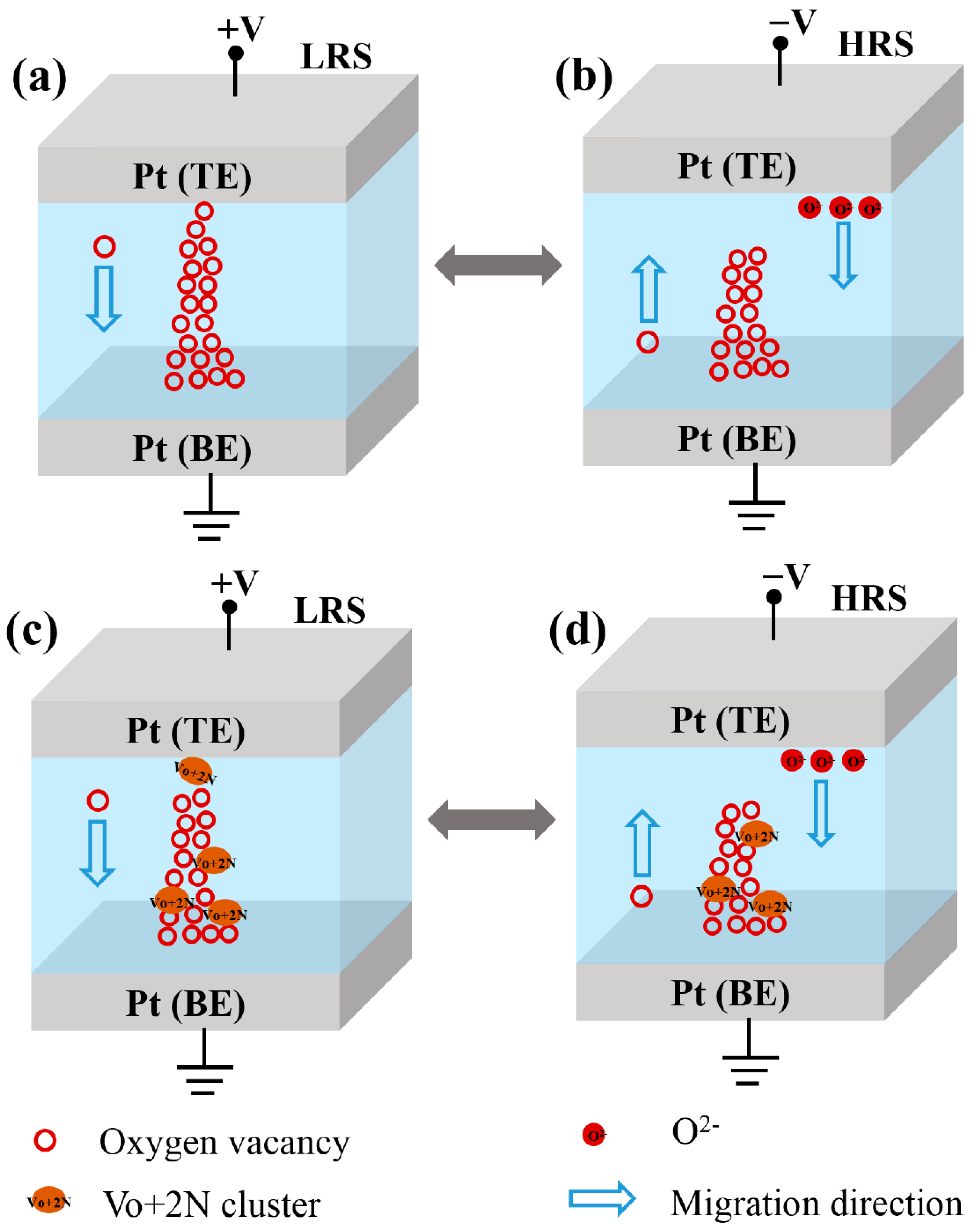
| Structure | Thickness (nm) | Deposition Method | I-V Characteristic | SET/RESET Voltage (V) | On/Off Ratio | Retention Time (s) | Ref |
|---|---|---|---|---|---|---|---|
| Au/Nb2O5/Pt | 60 | RF-sputtering | Bipolar | 0.96/−1.3 | 10 | - | [14] |
| Cu/Nb2O5/Pt | 11–14 | PLD | Bipolar | 1.5/ −0.5–−1 | ~200 | ~5 × 103 | [16] |
| Pt/Nb2O5/Pt | 26 | E-beam evaporation | Bipolar | 0.8/−0.8 | 20 | 3.6 × 104 | [28] |
| W/Nb2O5/NbOx/Ru | - | DC-sputtering | Bipolar | 1.1/ −1.5–−1.8 | ~50 | - | [29] |
| Al/Ti/SiO2:Nb2O5/TiN/Si | 18–22 | ALD | Bipolar | 1/−1 | <10 | - | [30] |
| Pt/Nb2O5/Pt/TiN/SiO2/Si | 50 | DC-sputtering | Unipolar | 1.7/0.8 | 100 | 1.67 × 104 | [31] |
| Pt/NbOx:N/Pt | ~15 | PLD | Bipolar | 0.4–1.0/ −0.4–−0.8 | ~103 | 6 × 104 | This work |
Publisher’s Note: MDPI stays neutral with regard to jurisdictional claims in published maps and institutional affiliations. |
© 2022 by the authors. Licensee MDPI, Basel, Switzerland. This article is an open access article distributed under the terms and conditions of the Creative Commons Attribution (CC BY) license (https://creativecommons.org/licenses/by/4.0/).
Share and Cite
Xu, J.; Zhu, Y.; Liu, Y.; Wang, H.; Zou, Z.; Ma, H.; Wu, X.; Xiong, R. Improved Performance of NbOx Resistive Switching Memory by In-Situ N Doping. Nanomaterials 2022, 12, 1029. https://doi.org/10.3390/nano12061029
Xu J, Zhu Y, Liu Y, Wang H, Zou Z, Ma H, Wu X, Xiong R. Improved Performance of NbOx Resistive Switching Memory by In-Situ N Doping. Nanomaterials. 2022; 12(6):1029. https://doi.org/10.3390/nano12061029
Chicago/Turabian StyleXu, Jing, Yuanyuan Zhu, Yong Liu, Hongjun Wang, Zhaorui Zou, Hongyu Ma, Xianke Wu, and Rui Xiong. 2022. "Improved Performance of NbOx Resistive Switching Memory by In-Situ N Doping" Nanomaterials 12, no. 6: 1029. https://doi.org/10.3390/nano12061029
APA StyleXu, J., Zhu, Y., Liu, Y., Wang, H., Zou, Z., Ma, H., Wu, X., & Xiong, R. (2022). Improved Performance of NbOx Resistive Switching Memory by In-Situ N Doping. Nanomaterials, 12(6), 1029. https://doi.org/10.3390/nano12061029






